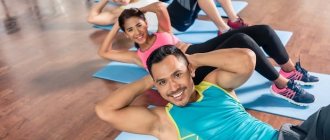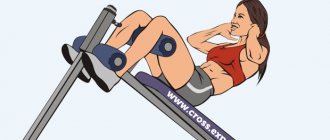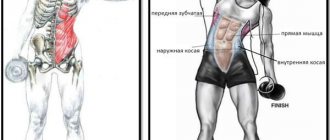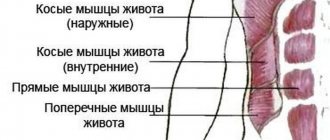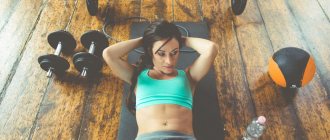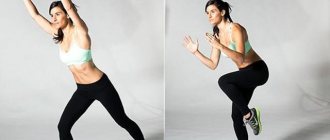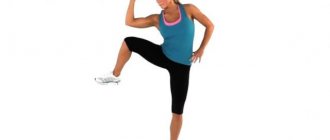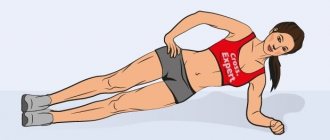© Kzenon — stock.adobe.com
Share:
What you need
- Dumbbells
- Fitball
- Horizontal bar
- Exercise equipment
- Pancakes from the barbell
- Ab roller
Both guys and girls pay a lot of attention to pumping up their abdominal muscles. In order for the abs to look harmonious, it is necessary to systematically develop absolutely all muscle groups located in this part of the body, and not just the straight and transverse ones. How to pump up the oblique abdominal muscles and which exercises are best suited for this - we will tell you in detail in this article.
Anatomy of oblique muscles
The abdominal muscles consist of several zones. In order for the abs to be more aesthetically pleasing, the athlete needs to work on it comprehensively.
The oblique muscles help a person bend and rotate their torso. The anatomical features of this muscle group allow you to maintain beautiful back posture and help shape a wasp-shaped female waist.
The structure of the muscle group
The oblique muscles of the press consist of an internal and external region. The external obliques begin in the region of the V-XII ribs, and are attached near the inguinal ligament, linea alba, pubic tubercle and crest.
The internal obliques originate from the inguinal ligament, iliac crest and thoracolumbar fascia. They are attached to the pubic crest, the linea alba and the cartilages of the IX-XII ribs.
Basic functions in the body
The oblique abdominal muscles allow anyone to perform a large number of movements. Their main function is to rotate the chest to the side. Also, this muscle zone plays an active role in many physiological processes occurring in the body. The oblique abdominal muscles are involved in tension in the abdominal region. This process occurs during childbirth, as well as during bowel movements.
A well-pumped muscle allows you to perform various flexions in the lower back. You can lean to the right and left, and also lift your pelvis forward. Regular training will help reduce the level of tension on the spine and correct your posture.
The benefits of training for oblique muscles
Pumping up the abdominal press allows the athlete to increase strength in other basic exercises. Exercises for the oblique abdominal muscles are performed not only by bodybuilders and powerlifters. Often this zone is also pumped up by track and field athletes (throwers of sports equipment), snowboarders, figure skaters, gymnasts, boxers, representatives of some team sports, and, of course, crossfitters.
However, do not forget that excessively pumped oblique muscles visually make the waist wider . If you do not want this effect, you should not put too much emphasis on this muscle group. 1-2 exercises per week is enough.
Common Injuries
It is very important to perform all movements with correct technique and also to work at a slow pace. Before starting the class, you should warm up well. Warm up not only your oblique muscles, but other parts of your body as well. This way you can avoid troubles and various injuries.
So, what injuries can result from improper exercise technique? Let's look at the most common problems, their causes and symptoms:
- The most common injury is a sprain. Athletes suffer similar damage during intense training. The structure of muscle tissue may be disrupted. If you feel sharp pain in the abdominal area and it is unpleasant to bend your body, consult a doctor. In some cases, athletes suffer from bruising. Your body temperature may rise. The duration of the recovery process depends entirely on the severity of the injury.
- Regular aching pain can occur if you exercise too often and too much. The athlete must rest well between training sessions to avoid the effects of overtraining. You don't need to pump up your abs every day .
- Pain in the abdominal area does not always occur due to errors in the technique. You could simply have been blown away. Be sure to consult a doctor if the problem cannot be solved on your own by reducing the frequency, intensity of training and reducing the load. An experienced specialist will be able to make the correct diagnosis and prescribe treatment.
Prevention of diastasis
To reduce the risk of developing pathology, it is extremely important to systematically follow preventive recommendations. To do this you need:
- adhere to a proper balanced diet;
- lead an active lifestyle, walk more;
- strengthen all muscle groups, especially the muscle structures of the abdomen and lumbar region;
- eliminate excessive physical activity;
- do not lift weights, especially for women;
- strengthen the diaphragm;
- monitor your weight and prevent obesity.
During pregnancy, you need to use special oils, creams, ointments that increase the elasticity and firmness of tissues. After childbirth, it is necessary to carefully monitor the condition of the press in order to detect pathology in a timely manner and, if necessary, seek help from a doctor before complications develop. Treatment of the initial stages of discrepancy is successful and does not require excessive effort from the patient.
Exercises for oblique abdominal muscles in the gym
Now let’s move from theory to practice and consider the most effective ways to pump up the oblique abdominal muscles. To do this, you must create a training program that will suit your individual characteristics.
The oblique abdominal muscles are a fairly large muscle area. She receives load not only during lateral twists. Other popular compound exercises will also have a positive effect on working this target muscle group.
The obliques are usually trained together with the rectus abdominis. In this case, the best option would be to do 2-3 exercises on the straight line and 1-2 on the obliques . In the gym, athletes work using special sports equipment. You may need weight plates, a fitball, and dumbbells.
Lateral crunches on a crossover
This exercise is performed using a block simulator or crossover:
- Grasp the rope handle that should be attached to the top pulley.
- Kneel with your back to the block.
- Pull your stomach in, tighten your abs.
- Exhale - bend your torso to the side, only the oblique muscles should participate in the work.
- At the bottom of the movement, you need to hold for a couple of seconds and tense your abs as much as possible.
- Inhale - return to the starting position under control.
Perform the movement only with the help of your abdominal muscles, do not bend over due to the efforts of your back. Don't move back and forth. Work smoothly, without jerking. You should do 10-15 reps per set. The number of approaches depends on the goals of the training process.
Turns on a block (“woodcutter”)
This movement is also performed on a block simulator or crossover. In addition to the oblique abdominal muscles, the transverse and straight sections receive load. The technique is as follows:
- Stand firmly on your feet with your side to the block, straighten your back.
- Turn around and grasp the rope handle with both hands. Do not bend them at the elbow joint.
- Turn your body to the side and bend over, while you need to hold the handle tightly and pull it to the thigh farthest from the block. Don't hunch your back.
- Return to the starting position.
- After completing 10-15 repetitions, stand on the other side of the machine and repeat.
Keep your arms straight throughout the exercise; do not bend them. Also, do not move using jerking movements. Legs should be in a static position.
Body turns on a fitball
Fitball is a special sports equipment that has the shape of a regular ball. It is very elastic and also quite large (diameter is about 65 centimeters). Such rotations of the body allow you to perfectly work the lateral abdominal muscles.
- Lie with your back on the fitball, the gluteal area should also be located on the ball.
- Spread your feet on the floor, lean firmly on them.
- Place your hands together behind your head. As an option, you can alternately reach with one hand towards the opposite leg, leaving the other behind your head.
- Tighten your abdominal muscles and smoothly turn to the right side, and then return to the starting position.
- Make a left turn. The lower back should not come off the ball.
© Mihai Blanaru — stock.adobe.com
Very often, experienced athletes train with weights. You can pick up a plate from a barbell or dumbbell. Hold them firmly with both hands. The number of repetitions is the same.
Tilts on the lower block
This exercise should be performed using a lower block:
- Stand firmly on your feet with your side to the block, straighten your back.
- Take with one hand the special handle that should be attached to the lower block. You can place your other hand behind your head or rest it on your side.
- Bend your torso in the opposite direction from the block.
- Pause for a couple of seconds at the bottom of the movement.
- Return to the starting position.
- After 12-15 repetitions, turn to the other side and then continue with the movements.
This exercise should also be done without jerking. You need to work at a slow pace.
Samson Tilts
Effective exercises for the oblique abdominal muscles are often performed using fairly heavy dumbbells. Samson tilts are one of the most popular such movements. This sports element was invented by the Lithuanian strongman Alexander Zass. His stage name is Amazing Samson.
To perform the exercise you will need a pair of dumbbells:
- Stand up straight, straighten your back. Feet shoulder width apart.
- Take dumbbells and lift them above your head in any convenient way.
- Slowly lower your body to the right side without bending your elbows.
- Return to the starting position.
- Lean to the left and return to IP again.
Work very carefully. Beginners should take light dumbbells up to 10 kg. Make sure that the projectiles do not fall down. Here, 3 approaches will be enough, in which you need to do 10-12 repetitions.
How to train correctly?
To lose weight and reduce fat on the sides and abdomen, the exercise should be performed according to the following scheme:
- First of all, you need to overcome the desire to take a heavy dumbbell. Firstly, it is dangerous for the spine. Secondly, training with heavy weights leads to muscle growth, and increasing the volume of oblique muscles is not part of our plans. The weight should be no more than 5–7 kg for men and no more than 3–5 kg for women. It is better to take less weight, but do more repetitions.
- We do at least 20 repetitions on each side, 3-4 approaches. We take minimal rest between sets. Alternate approaches left and right.
- The repetitions are performed at a relatively fast pace, but without jerking and always with tense abs.
- It is better to include side bends in the training program as an additional exercise. That is, we leave it at the end of the workout, when the main exercises have already been completed.
A significant fat-burning effect is achieved only with appropriate adjustments to the diet. Also, the process of losing weight will go faster with increasing cardio loads.
There is a popular myth that exercise can remove fat from a certain part of the body. But, in fact, there is no local weight loss, and until a certain calorie deficit is created, fat deposits on the waist and sides will not begin to decrease, no matter how many bends you do.
Bends alone are not enough to lose weight. The nutritional plan must be adjusted.
But what if your goal is not to burn fat, but to work out your abdominal muscles? In such a situation, it must be said that the oblique muscles, one way or another, are involved in the work when performing any abdominal exercises. Of course, you can additionally load them with tilts, the main thing is to strictly follow the technique.
To work the muscles:
- Side bends are performed slowly.
- 8–12 reps on each side, 2–3 sets. We alternate approaches to the left and to the right.
- You still can’t take on a lot of weight.
Nuances of training for women
Most often, guys and girls who work out in the gym do the same abdominal exercises. The structure of this muscle zone is identical in representatives of different sexes. Thus, women can benefit from any available abdominal exercise.
However, it should be noted that there are still several features of the training process for the fair sex:
- You need to perform only those movements that do not cause any discomfort, pain or other unpleasant sensations (this is also true for men).
- Girls should exercise without the help of heavy sports equipment. Strength work can lead to an enlarged waist, which is unlikely to be the effect you were looking for.
- Do not strive to complete complex tasks, focus on simple exercises that will help you work the target muscle group comprehensively. Simple does not mean ineffective.
- Women do not necessarily need to specifically focus on movements that are designed to pump up the lateral abdominal muscles - exercises on the rectus abdominis muscle will be quite enough.
What is diastasis
To understand this concept, it is necessary to briefly outline the structural features of the abdominal muscles. In the center of the abdomen is the rectus muscle. It begins in the lower abdomen and extends to the pubic bone. Consists of two sections that are connected in the center by loose fabric. This connective tissue is called the linea alba.
As a result of prolonged and strong tension of muscle structures, intra-abdominal pressure increases. Weak tissues of the white line cannot withstand the load and begin to diverge. At the same time, the distance between the sections of the rectus muscle increases, they diverge to the sides and move several centimeters away from each other. A kind of furrow is formed, and when tense, the stomach protrudes unnaturally. Pathological discrepancy can form under the navel, above it, or have a mixed form.
The pathology should not be confused with a hernia of the white line or with an umbilical protrusion. It does not threaten to infringe on internal organs. But at the same time, even at an early stage it represents an aesthetic problem, since diastasis of the rectus abdominis muscle is much more often determined in women than in men.
Depending on the degree of discrepancy and the size of the formed distance, diastasis is divided into three degrees:
- first - the distance between sections is from 2.5 to 5 cm;
- second - the discrepancy reaches a gap of 5-8 cm;
- third - the size of the furrow between the sections exceeds 8 cm.
This classification allows you to understand how to determine the degree of muscle diastasis even at home.
Pathology can also affect other muscle structures of the anterior abdominal wall. Depending on what surrounding tissues are involved in the process, four types of diastasis are distinguished:
- A - classic form, in which only the rectus muscle diverges;
- B - loss of tone in the inferolateral muscle sections;
- C - appearance of expansion in the area of the xiphoid process, ribs;
- D - curvature of the waist line.
Service
Program for indoor classes
How to pump up your oblique abdominal muscles in the gym? There are two main options - to pump up your abs once a week (4-6 exercises) or at the end of each workout (3 times a week, 2-3 exercises). In the first option, 3-4 exercises will be on the rectus abdominis muscle and 1-2 on the obliques. In the second - 1-2 on a straight line and 1 on obliques.
An approximate lesson plan in the first version may consist of the following exercises:
| Exercise name | Abdominal muscles involved | Number of approaches and repetitions | Photo |
| Incline crunches | Straight | 3x12-15 | |
| Hanging Leg Raises | Straight | 3x10-15 | |
| Crunches in the simulator | Straight | 3x12-15 | |
| Lateral crunches on a crossover | Oblique | 3x12-15 | |
| Tilts on the lower block | Oblique | 3x12-15 |
In the second case, you can alternate exercises, for example, in the first workout:
| Exercise name | Abdominal muscles involved | Number of approaches and repetitions | Photo |
| Incline crunches | Straight | 3x12-15 | |
| Hanging Leg Raises | Straight | 3x10-15 | |
| "Lumberjack" on the block | Oblique | 4x12-15 |
On the second:
| Exercise name | Abdominal muscles involved | Number of approaches and repetitions | Photo |
| Crunches in the simulator | Straight | 3x12-15 | |
| Reverse crunches on a bench | Straight | 3x10-15 | |
| Body turns on a fitball | Oblique | 3x12-15 | © Mihai Blanaru — stock.adobe.com |
And on the third:
| Exercise name | Abdominal muscles involved | Number of approaches and repetitions | Photo |
| Elbow plank | Straight | 3x60-90 sec |
|
| Hanging Corner | Straight | 3x60-90 sec |
|
| Lateral crunches on a crossover | Oblique | 4x12-15 |
Exercises for home workouts
How to pump up your oblique abdominal muscles at home? Very simple! The oblique muscle exercises we suggest below can be performed in almost any environment. In order to pump up your abs well, you don’t always need to buy an expensive subscription to a fitness center. The main thing is to have patience and strive for your goal.
Twisting with body rotation
This movement is performed by all athletes who strive to effectively work out the oblique abdominal muscles. The exercise allows you to well load the internal and external oblique areas of the press.
The technique is as follows:
- Lie down on the floor. Legs must be bent at the knees.
- Your hands should be placed at the back of your head; do not move them while performing crunches. Elbows need to be spread to the sides.
- Using your abs, lift your upper body off the surface. In this case, the lower back should be pressed throughout the entire approach.
- Turn your torso to the side as if you are reaching with your left elbow towards your right leg.
- Return to the starting position.
- Perform a twist in the other direction. You can also rest your ankle on the knee of your other leg and perform crunches on one side first, and then switch legs and perform them on the other.
© Andrey Popov — stock.adobe.com
Work at a slow pace. While moving, you should not pull your head with your hands. Number of repetitions – 12-15.
Side crunches
This exercise will help specifically pump up the internal and external oblique abdominal muscles. It is very important to perform all movements technically correctly:
- Lie on your side. The legs can be slightly bent at the knee joint.
- Your right hand (if you are lying on your right side) must be straightened forward and placed on the floor, hold your left hand behind your head.
- Using the lateral press, lift your torso up.
- Fix your body position at the top point of the movement for a couple of seconds.
- Return to the starting position.
- Perform several 12-15 repetitions of side crunches.
- Turn over to the other side.
It is very important to keep your back straight without arching it. Work smoothly, without sudden jerks.
Lateral bends
This exercise is often performed in the gym with dumbbells in your hands. At the initial stage, it can be done without additional weights:
- Stand firmly on the floor. Feet shoulder width apart.
- Raise your hands up and clasp them in a lock. Or raise one hand up and place the other on your waist (when you change the side of the tilt, your hands also change position).
- Do not bend your back, tilt your body to the side.
- Return to the starting position; movements should be performed along the body in one plane.
- Do about 15 reps on each side.
© Africa Studio - stock.adobe.com
More experienced athletes are best trained with weights. At home, you can use a regular backpack. You need to put books in the bag and then take it in your hand.
© Mihai Blanaru — stock.adobe.com
Leg raise while lying on your side
This movement will help develop not only your lateral abs, but also your gluteal area and outer thigh. Recommended for girls.
- Lie on your side. The lower arm must be straightened towards the head, and the other bent at the elbow joint. Place it in the chest area.
- Close your legs together and then lift them as high as possible. To accentuate the obliques, you can also elevate your torso.
- Lower your legs and body down. Do this smoothly, do not relax your abdominal muscles.
- Perform about 10-12 repetitions, and then turn to the other side.
© Mihai Blanaru — stock.adobe.com
You can work without the help of special weights.
Hanging pelvic rotations
To perform hanging turns you will need a horizontal bar:
- Jump onto the bar. Bend your knees.
- Raise your knees up, while you need to tilt them alternately to different sides. Try to do this using your abdominal muscles, not your legs.
- At the top of the movement, fix the position of your legs for a second.
- Perform several hanging pelvic rotations in a row.
© Fxquadro — stock.adobe.com
A more difficult option would be to raise straight legs rather than knees.
V-turns
This exercise is quite difficult; it is best to do it first in oblique training. The technique is as follows:
- Lie on your back. Stand up straight.
- Raise your torso and legs simultaneously. Support is on the buttocks. You can bend your legs a little if you find it difficult to keep them straight
- At the top of the movement, turn your body to the side.
- Return to the starting position.
- Lift up and turn the other way.
© Bojan - stock.adobe.com
Work smoothly. Most often, athletes perform 8-12 V-turns on each side. When performing the exercise, you can work only with your own weight or use weights. These don't have to be weights or dumbbells - you can even take a regular bottle of water in your hands.
Home workout program
At home, the principles of building a program are no different from training in the gym. Only the exercises change.
Program for training the abs once a week:
| Exercise name | Abdominal muscles involved | Number of approaches and repetitions | Photo |
| Straight crunches on the floor | Straight | 3x12-15 | |
| Reverse crunches on the floor | Straight | 3x10-15 |
|
| Crunches with legs raised | Straight | 3x10-15 |
|
| V-turns | Oblique | 3x8-12 | © Bojan - stock.adobe.com |
| Lateral bends | Oblique | 3x12-15 | © Africa Studio - stock.adobe.com |
Three day program. First workout:
| Exercise name | Abdominal muscles involved | Number of approaches and repetitions | Photo |
| Sitap | Straight | 3x10-15 | |
| Running while lying down | Straight | 3x10-15 |
|
| Side crunches | Oblique | 4x12-15 |
Second:
| Exercise name | Abdominal muscles involved | Number of approaches and repetitions | Photo |
| Crunches on the floor | Straight | 3x12-15 | |
| Reverse crunches on the floor | Straight | 3x10-15 | © artinspiring — stock.adobe.com |
| Leg raises lying on your side | Oblique | 3x12-15 | © Mihai Blanaru — stock.adobe.com |
Third:
| Exercise name | Abdominal muscles involved | Number of approaches and repetitions | Photo |
| Elbow plank | Straight | 3x60-90 sec | © Makatserchyk — stock.adobe.com |
| Rolling out on a roller for the press | Straight | 3x10-12 |
|
| Hanging pelvic rotations | Oblique | 3x10-15 | © Fxquadro — stock.adobe.com |
Recipes for healthy eating
Fresh spinach salad with mozzarella
- 2.3 g Protein
- 5.9 g Fat
- 3.6 g Carbohydrates
- 70.5 kcal
15-20 min.
- #pomegranate
- #walnuts
- #pears
- #dietary
- #low calorie
- #dinner
- #olive oil
- #cheese
- #dinner
- #fruits
- #spinach
Other recipes
Tips and tricks before training
In general, in order to pump up the press correctly, you need to follow simple recommendations:
- Eat a light meal 2–2.5 hours before class. If you exercise on an empty stomach, you will not give your full strength, which means the workout will be ineffective. An overfull stomach can also leave negative consequences, such as nausea and severe dizziness.
- Warm up your muscles with a light warm-up. Jump, run in place or on a machine, perform simple techniques such as turns, bends and rotations.
- Do not overdo it! There is no need to exhaust yourself every day. Exercise 2-4 times a week - this will be enough for a beautiful and sculpted belly.
- Every exercise should stretch your muscles. You should feel how tense they are. If it doesn't, then you're doing something wrong.
- Don't eat immediately after training. If you feel very hungry, snack on an apple or drink a glass of water. Start eating no earlier than an hour later.
Attention! Don't be afraid if you get tired quickly while practicing. Since the muscular frame of the abdomen is difficult to stretch, such a reaction is quite normal.
